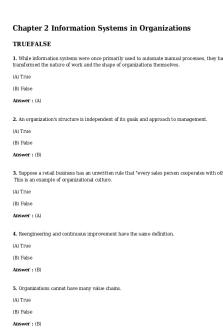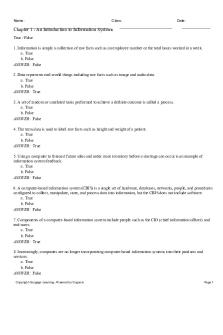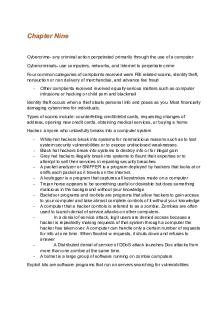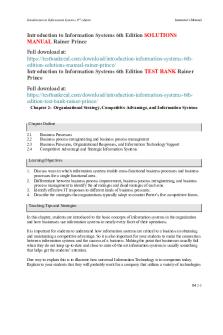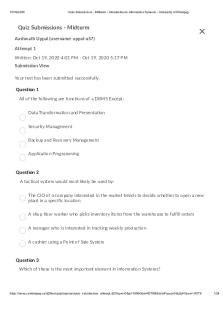OBrien - Introduction to Information Systems [2010] PDF
![OBrien - Introduction to Information Systems [2010]](https://pdfedu.com/img/crop/300x450/zx28ke2j06rw.jpg)
| Title | OBrien - Introduction to Information Systems [2010] |
|---|---|
| Author | Israel Hernandez |
| Pages | 626 |
| File Size | 29 MB |
| File Type | |
| Total Downloads | 691 |
| Total Views | 867 |
Summary
This page intentionally left blank INTRODUCTION TO INFORMATION SYSTEMS This page intentionally left blank INTRODUCTION TO INFORMATION SYSTEMS Fifteenth Edition James A. O’Brien College of Business Administration Northern Arizona University George M. Marakas KU School of Business University of Kansa...
Description
This page intentionally left blank
obr76779_fm_i-xxxiii.indd Page i 9/25/09 8:45:02 PM s-206
INTRODUCTION TO INFORMATION SYSTEMS
/Users/s-206/Desktop/Tempwork/September/25:09:09/MHBR112:204:Oberain
This page intentionally left blank
obr76779_fm_i-xxxiii.indd Page iii 10/9/09 7:19:23 AM s-206
INTRODUCTION TO INFORMATION SYSTEMS Fifteenth Edition
James A. O’Brien College of Business Administration Northern Arizona University
George M. Marakas KU School of Business University of Kansas
/Volumes/204/MHBR112/obr76779/0073376779/obr76779_pagefiles
obr76779_fm_i-xxxiii.indd Page iv 10/2/09 1:31:00 PM user
/Users/user/Desktop/Temp Work/SEPTEMBER_2009/00 HARISH_BACKUP/OCTOBER_2009/02...
INTRODUCTION TO INFORMATION SYSTEMS Published by McGraw-Hill/Irwin, a business unit of The McGraw-Hill Companies, Inc., 1221 Avenue of the Americas, New York, NY, 10020. Copyright © 2010, 2008, 2007, 2005, 2003, 2001, 2000, 1997, 1994, 1991, 1988, 1985, 1982, 1978, 1975 by The McGraw-Hill Companies, Inc. All rights reserved. No part of this publication may be reproduced or distributed in any form or by any means, or stored in a database or retrieval system, without the prior written consent of The McGraw-Hill Companies, Inc., including, but not limited to, in any network or other electronic storage or transmission, or broadcast for distance learning. Some ancillaries, including electronic and print components, may not be available to customers outside the United States. This book is printed on acid-free paper. 1 2 3 4 5 6 7 8 9 0 DOW/DOW 0 9 ISBN 978–0-07–337677-6 MHID 0–07-337677–9 Vice president and editor-in-chief: Brent Gordon Publisher: Paul Ducham Director of development: Ann Torbert Development editor II: Trina Hauger Vice president and director of marketing: Robin J. Zwettler Marketing manager: Natalie Zook Vice president of editing, design and production: Sesha Bolisetty Senior project manager: Bruce Gin Lead production supervisor: Carol A. Bielski Senior designer: Mary Kazak Sander Senior photo research coordinator: Lori Kramer Media project manager: Joyce J. Chappetto Cover design: Mary Sanders Interior design: Mary Sanders Typeface: 10/12 Janson Compositor: Aptara®, Inc. Printer: R. R. Donnelley
Library of Congress Cataloging-in-Publication Data O’Brien, James A., 1936–2007 Introduction to information systems / James A. O’Brien, George M. Marakas.—Fifteenth ed. p. cm. Includes index. ISBN-13: 978–0-07–337677-6 (alk. paper) ISBN-10: 0–07-337677–9 (alk. paper) 1. Business—Data processing. 2. Management—Data processing. 3. Management information systems. 4. Electronic commerce. I. Marakas, George M. II. Title. HF5548.2.O23 2010 658.4’038—dc22 2009036062
www.mhhe.com
obr76779_fm_i-xxxiii.indd Page v 9/25/09 8:45:03 PM s-206
/Users/s-206/Desktop/Tempwork/September/25:09:09/MHBR112:204:Oberain
To your love, happiness, and success. The world of information systems presents new and exciting challenges each and every day. Creating a textbook to capture this world is a formidable task, to be sure. This, the 15th edition of Introduction to Information Systems, represents the best we have to offer. We take pride in delivering this new edition to you and we thank all of you for your loyalty to the book and the input you provided that was instrumental in its development. Your continued support fills us with joy and a sense of both accomplishment and contribution. We are also pleased and excited to welcome a new member to our writing family. Miguel Aguirre-Urreta has joined us in the creation of the materials contained herein. His work and effort on the Real World Cases and blue boxes will be apparent as we bring you new cases in every chapter of the book. Please join us in welcoming Miguel to our family. On behalf of Jim, Miguel, and myself, please accept our sincere appreciation for your support and loyalty. As always, we hope you enjoy and benefit from this book.
obr76779_fm_i-xxxiii.indd Page vi 10/2/09 1:22:31 PM user
/Users/user/Desktop/Temp Work/SEPTEMBER_2009/00 HARISH_BACKUP/OCTOBER_2009/02...
About the Authors
J
ames A. O’Brien was an adjunct professor of Computer Information Systems in the College of Business Administration at Northern Arizona University. He completed his undergraduate studies at the University of Hawaii and Gonzaga University and earned an MS and PhD in Business Administration from the University of Oregon. He has been professor and coordinator of the CIS area at Northern Arizona University, professor of Finance and Management Information Systems and chairman of the Department of Management at Eastern Washington University, and a visiting professor at the University of Alberta, the University of Hawaii, and Central Washington University. Dr. O’Brien’s business experience includes working in the Marketing Management Program of the IBM Corporation, as well as serving as a financial analyst for the General Electric Company. He is a graduate of General Electric’s Financial Management Program. He also has served as an information systems consultant to several banks and computer services firms. Jim’s research interests lie in developing and testing basic conceptual frameworks used in information systems development and management. He has written eight books, including several that have been published in multiple editions, as well as in Chinese, Dutch, French, Japanese, and Spanish translations. He has also contributed to the field of information systems through the publication of many articles in business and academic journals, as well as through his participation in academic and industry associations in the field of information systems.
G
eorge M. Marakas is a professor of Information Systems at the School of Business at the University of Kansas. His teaching expertise includes Systems Analysis and Design, Technology-Assisted Decision Making, Electronic Commerce, Management of IS Resources, Behavioral IS Research Methods, and Data Visualization and Decision Support. In addition, George is an active researcher in the area of Systems Analysis Methods, Data Mining and Visualization, Creativity Enhancement, Conceptual Data Modeling, and Computer Self-Efficacy. George received his PhD in Information Systems from Florida International University in Miami and his MBA from Colorado State University. Prior to his position at the University of Kansas, he was a member of the faculties at the University of Maryland, Indiana University, and Helsinki School of Economics. Preceding his academic career, he enjoyed a highly successful career in the banking and real estate industries. His corporate experience includes senior management positions with Continental Illinois National Bank and the Federal Deposit Insurance Corporation. In addition, George served as president and CEO for CMC Group Inc., a major RTC management contractor in Miami, Florida, for three years. Throughout his academic career, George has distinguished himself both through his research and in the classroom. He has received numerous national teaching awards, and his research has appeared in the top journals in his field. In addition to this text, he is
vi
obr76779_fm_i-xxxiii.indd Page vii 9/25/09 8:45:04 PM s-206
/Users/s-206/Desktop/Tempwork/September/25:09:09/MHBR112:204:Oberain
About the Authors ●
vii
the author of three best-selling textbooks on information systems: Decision Support Systems for the 21st Century, Systems Analysis and Design: An Active Approach, and Data Warehousing, Mining, and Visualization: Core Concepts. Beyond his academic endeavors, George is also an active consultant and has served as an advisor to a number of organizations, including the Central Intelligence Agency, Brown & Williamson, the Department of the Treasury, the Department of Defense, Xavier University, Citibank Asia-Pacific, Nokia Corporation, Professional Records Storage Inc., and United Information Systems. His consulting activities are concentrated primarily on electronic commerce strategy, the design and deployment of global IT strategy, workflow reengineering, e-business strategy, and ERP and CASE tool integration. George is also an active member of a number of professional IS organizations and an avid golfer, second-degree Black Belt in Tae Kwon Do, a PADI master scuba diver trainer and IDC staff instructor, and a member of Pi Kappa Alpha fraternity.
obr76779_fm_i-xxxiii.indd Page viii 10/8/09 7:05:30 PM user-f501
/Users/user-f501/Desktop/MHBR112:O'BREN:204
The O’Brien and Marakas Approach The first thing you probably noticed about this new edition is the new, loose-leaf format. The 15th edition was produced this way in order to deliver a couple of important benefits for instructors and students.
• Lower cost to students—the loose-leaf format allows us to substantially lower the • •
price that your campus bookstore pays for each copy, which should translate to a substantially lower price for each student. Less frequent course prep for faculty—We expect that, by providing students with this cost-competitive alternative to a used book, we won’t need to revise the book as frequently. So instructors will get additional semesters out of their prep with this edition. Improved portability—Students and instructors need only carry the chapter required for today’s lecture, leaving the rest in a three ring binder.
If for any reason you need a bound book for your class, simply contact your McGraw-Hill representative. They will arrange to have bound copies of Introduction to Information Systems, 15th edition produced for your adoption.
A Business and Managerial Perspective The Fifteenth Edition is designed for business students who are or who will soon become business professionals in the fast-changing business world of today. The goal of this text is to help business students learn how to use and manage information technologies to revitalize business processes, improve business decision making, and gain competitive advantage. Thus, it places a major emphasis on up-to-date coverage of the essential role of Internet technologies in providing a platform for business, commerce, and collaboration processes among all business stakeholders in today’s networked enterprises and global markets. This is the business and managerial perspective that this text brings to the study of information systems. Of course, as in all O’Brien texts, this edition:
• Loads the text with Real World Cases, in-depth examples (Blue Boxes), and
• •
opportunities to learn about real people and companies in the business world (Real World Activities, Case Study Questions, Discussion Questions, and Analysis Exercises). Organizes the text around a simple Five-Area Information Systems Framework that emphasizes the IS knowledge a business professional needs to know. Places a major emphasis on the strategic role of information technology in providing business professionals with tools and resources for managing business operations, supporting decision making, enabling enterprise collaboration, and gaining competitive advantage.
Modular Structure of the Text
viii
The text is organized into MODULE I modules that reflect the Foundation five major areas of the Concepts Chapters 1, 2 framework for information systems knowledge. Each chapter is then organized into two or more distinct sections to provide MODULE V MODULE II MODULE IV MODULE III the best possible concepManagement Information Development Business tual organization of the Challenges Technologies Processes Applications text and each chapter. This Chapters 11, 12 Chapters 3, 4, 5, 6 Chapter 10 Chapters 7, 8, 9 organization increases instructor flexibility in assigning course material because it structures the text into modular levels (i.e., modules, chapters, and sections) while reducing the number of chapters that need to be covered.
obr76779_fm_i-xxxiii.indd Page ix 9/25/09 8:45:06 PM s-206
/Users/s-206/Desktop/Tempwork/September/25:09:09/MHBR112:204:Oberain
An Information Systems Framework Business Applications How businesses use the Internet and other information technologies to support their business processes, e-business and e-commerce initiatives, and business decision making (Chapters 7, 8, and 9).
Management Challenges
Business Applications
Information Systems
Development Processes
Management Challenges The challenges of business/IT technologies and strategies, including security and ethical challenges and global IT management (Chapters 11 and 12).
Information Technologies Information Technologies
Foundation Concepts
Includes major concepts, developments, and managerial issues involved in computer hardware, software, telecommunications networks, data resource management technologies, and other technologies (Chapters 3, 4, 5, and 6).
Development Processes Developing and implementing business/IT strategies and systems using several strategic planning and application development approaches (Chapter 10).
Foundation Concepts Fundamental business information systems concepts, including trends, components, and roles of information systems (Chapter 1) and competitive advantage concepts and applications (Chapter 2). Selective coverage of relevant behavioral, managerial, and technical concepts.
ix
obr76779_fm_i-xxxiii.indd Page x 10/21/09 3:50:03 AM user-f498
/Users/user-f498/Desktop
Real World Examples Real World Cases Each chapter provides three Real World Cases—in-depth examples that illustrate how prominent businesses and organizations have attempted to implement the theoretical concepts students have just learned. obr76779_ch05_169-206.indd Page 171 10/15/09 2:42:48 AM user-f498
/Users/user-f498/Desktop/TEMPWORK/OCTOBER/09:10/MHBR144
Chapter 5 / Data Resource Management ● 171
REAL WORLD
CASE
W
1
Cogent Communications, Intel, and Others: Mergers Go More Smoothly When Your Data Are Ready
hen Cogent Communications eyes a company to acquire, it goes into battle mode. Two miles north of the Pentagon, across the Potomac in Washington, Cogent sets up what it calls the War Room, where it marshals eight top executives to evaluate the target company. Among those on the due diligence squad are the IS director and IT infrastructure manager. Cogent, a midsize Internet service provider, understands what far too many companies don’t: Its ability to integrate and, in some cases, adopt an acquired company’s IT systems and operations can determine whether a merger flourishes or founders. For one thing, unanticipated IT integration costs can offset merger savings. Imagine the business lost when orders vanish, accounts payable go uncollected, and customer information goes AWOL because the acquiring company gave short shrift to the IT challenge ahead. As 2006 came to a close, it broke records for the number of mergers and acquisitions, but now IT managers have to step up and make sure their data centers can help make those deals a reality. “A well-run data center with reduced complexity makes mergers and acquisitions much easier,” says Andi Mann, senior analyst at Enterprise Management Associates (EMA). More than 11,700 deals were done. As the dust clears, experts and IT managers agree that companies will feel the full impact of this merger and acquisition (M&A) frenzy directly in their data centers. So they advise organizations to prep now or risk experiencing downtime if they have to merge mission-critical assets. “Today, the most downtime companies can afford for critical data center infrastructure is
FI GURE 5 .1
IT integration and adoption issues can make or break merger and acquisition activities.
Source: McGraw-Hill Companies, Inc./John Flournoy, photographer.
x
measured in minutes.” Merged and acquired infrastructure “has to be available right away,” says Ryan Osborn of AFCOM, a data center industry group. Observers agree that the key to M&A success from a data center perspective is to focus on virtualization, documentation, and logistics. Osborn says these three areas will help companies get ahead of the game and turn a time of crisis into one of opportunity. “You won’t spend your time just moving infrastructure from one data center to another. You can actually do a technology refresh, get newer equipment and come out ahead,” he says. For John Musilli, data center operations manager at Intel in Santa Clara, California, the most critical piece is knowing about basic logistics. “I don’t always have to know what a server does, but I do have to know how to keep it alive,” he says. “It’s getting something moved from Point A to Point B and it doesn’t matter whether the logistics deals with putting servers on a truck or transferring data over a line.” Musilli has been through a handful of acquisitions in his eight years at Intel, and he says that he has it down to a science. “As part of the acquiring company, it’s my job to provide the skeletal environment to accept any company’s assets that come to us,” he says. As such, he keeps a healthy amount of generic racking, generic cabling, extra bandwidth on the network, and generic power. “I go generic because I probably won’t know what servers, how many slots, or what type of power we’ll need beforehand. With generic, I can configure whatever I need in minutes,” he says. For instance, he uses a universal busway for power so that he doesn’t have to be concerned about the particular electrical needs of the acquired equipment. “We acquired a company and needed to integrate them in a short period of time because their building lease was up and they had to get out of there,” Musilli says. One team was sent ahead of time and spent a year trying to identify each server on 30–40 racks. “None of their applications matched our operating systems,” he says. As time dwindled, Musilli told them to pack up all the servers and send them to him. “In the end, it took two man-days to move them intact and get them up and running in our data center,” he says. As companies begin to contemplate future mergers or acquisitions, they must look inward at their own processes and procedures. “Just as important as technology is documentation of processes—you have to know what people are doing with the systems,” says EMA’s Mann. He warns that one of the first obstacles to having a successful merger or acquisition is the reliance on what he refers to as tribal knowledge. Companies that have data centers where the employees hold all the knowledge suffer greatly when, after a merger or acquisition, those people are let go. “You have to document the knowledge from those people and figure out how to make the processes work with only a handful of employees,” he says. Mann recommends
obr76779_fm_i-xxxiii.indd Page xi 9/25/09 8:45:13 PM s-206
/Users/s-206/Desktop/Tempwork/September/25:09:09/MHBR112:204:Oberain
Real Life Lessons Use Your Brain Traditional case study questions promote and provide opportunity for critical thinking and classroom discussion. obr76779_ch05_169-206.indd Page 172 9/3/09 3:15:06 AM user-f501
/Users/user-f501/Desktop
172 ● Module II / Information Technologies creating a workflow chart that outlines who’s responsible for each part of the data center. He suggests considering who handles network management, systems management, application management, and storage. “This will also help you spot redundancies in skill sets or areas where you are lacking in the event of a merger,” he says. John Burke, senior analyst at Nemertes Research in Minneapolis, says that in addition to knowing who is responsible, IT groups must know which system...
Similar Free PDFs

Introduction to Sensory Systems
- 4 Pages

Introduction to Digital Systems
- 222 Pages
Popular Institutions
- Tinajero National High School - Annex
- Politeknik Caltex Riau
- Yokohama City University
- SGT University
- University of Al-Qadisiyah
- Divine Word College of Vigan
- Techniek College Rotterdam
- Universidade de Santiago
- Universiti Teknologi MARA Cawangan Johor Kampus Pasir Gudang
- Poltekkes Kemenkes Yogyakarta
- Baguio City National High School
- Colegio san marcos
- preparatoria uno
- Centro de Bachillerato Tecnológico Industrial y de Servicios No. 107
- Dalian Maritime University
- Quang Trung Secondary School
- Colegio Tecnológico en Informática
- Corporación Regional de Educación Superior
- Grupo CEDVA
- Dar Al Uloom University
- Centro de Estudios Preuniversitarios de la Universidad Nacional de Ingeniería
- 上智大学
- Aakash International School, Nuna Majara
- San Felipe Neri Catholic School
- Kang Chiao International School - New Taipei City
- Misamis Occidental National High School
- Institución Educativa Escuela Normal Juan Ladrilleros
- Kolehiyo ng Pantukan
- Batanes State College
- Instituto Continental
- Sekolah Menengah Kejuruan Kesehatan Kaltara (Tarakan)
- Colegio de La Inmaculada Concepcion - Cebu
![OBrien - Introduction to Information Systems [2010]](https://pdfedu.com/img/crop/172x258/zx28ke2j06rw.jpg)
